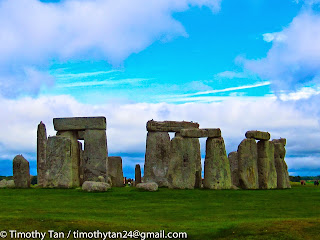UK, England, Stonehenge - 5000 Years of History
Stonehenge is world famous, being known as a prehistoric monument made of monolithic stones. Located in Wiltshire, England and about a few hours drive from London (depending on how fast the drive is!), Stonehenge is probably one of the most accessible of the ancient monolithic sites in the world. Visitors to Stonehenge will notice the roads that ran just in front of Stonehenge (near the Heel Stone) and the herds of livestock grazing near the monument.
Stonehenge was added to the list of UNESCO World Heritage Sites in 1986 together with Avebury Henge.
Stonehenge was added to the list of UNESCO World Heritage Sites in 1986 together with Avebury Henge.
Stonehenge, bathe in an almost magical glow in the early morning light, Wilshire, England, UK (2011)
Today, it is a known fact that Stonehenge wasn't built in a single time period. It was built, re-built and added upon over thousands of years dating possibly as far back as 3000 BC to about 1600 BC.
To the uninterested and uninspired visitor, Stonehenge is probably just a bunch of large stones placed in the middle of some place by some ancient people. Their purpose can be anything from astronomy to worship to being a sacrificial site.
To the uninterested and uninspired visitor, Stonehenge is probably just a bunch of large stones placed in the middle of some place by some ancient people. Their purpose can be anything from astronomy to worship to being a sacrificial site.
However, to someone who sees beyond a large grouping of huge stones, Stonehenge can mean a lot of other things. As I walked in a circular clock-wise direction around the monument, I started to think about the people who built this place. Questions such as why they built it, how they built it, what made them built it, constantly runs through my mind. Until today, nobody knows for sure the answers to these questions. As scholars of various fields of studies continue to debate the probable answers to these questions, new things and facts are constantly being discovered about Stonehenge!
The mystery of the people who are the builders of Stonehenge and their decision to build this place certainly leaves much for one to ponder about. And there are also much folklore associated with Stonehenge!
In this blogpost, I am sharing a selection of photos of Stonehenge which I took as I circled the monument. The photos are shown in a chronological order i.e. if you are to visit Stonehenge yourself and are to walk around the monolith in a clockwise direction as I did, you will be seeing the same progressive views as depicted by these photos listed here. Enjoy the photos! :-)
Stonehenge, Wiltshire, England, UK (2011)
Stonehenge, Wiltshire, England, UK (2011)
Stonehenge, Wiltshire, England, UK (2011)
Lone stone at Stonehenge, Wiltshire, England, UK (2011)
Stonehenge, Wiltshire, England, UK (2011)
Stonehenge, Wiltshire, England, UK (2011)
Stonehenge, Wiltshire, England, UK (2011)
Stonehenge, Wiltshire, England, UK (2011)
This lone stone is known as the Heel Stone (a.k.a. Sun Stone), its measures about 5 metres in height and leans slightly towards the centre of the main group of stones that made up Stonehenge, Wiltshire, England, UK (2011)
The white rock in front (just to the right of the picture) is said to be where human sacrifice were conducted during ancient times! However, this is just a theory and no conclusive evidence have been found to support this theory. Stonehenge, Wiltshire, England, UK (2011)
A local bird decides to pay a visit. Stonehenge, Wiltshire, England, UK (2011)
Wooden fencing separates Stonehenge from the rest of the rolling countryside of Wiltshire. England, UK (2011)
Panoramic view of the livestock that grazes lazily in the rolling countryside just a stone's throw from Stonehenge. Wilshire, England (2011)
The author, Timothy Tan, at Stonehenge. Note that I had dutifully complied to the instructions given by the sign in the grass to stay within a respectable distance from the monument. Stonehenge, Wiltshire, England (2011)


















Comments
Post a Comment